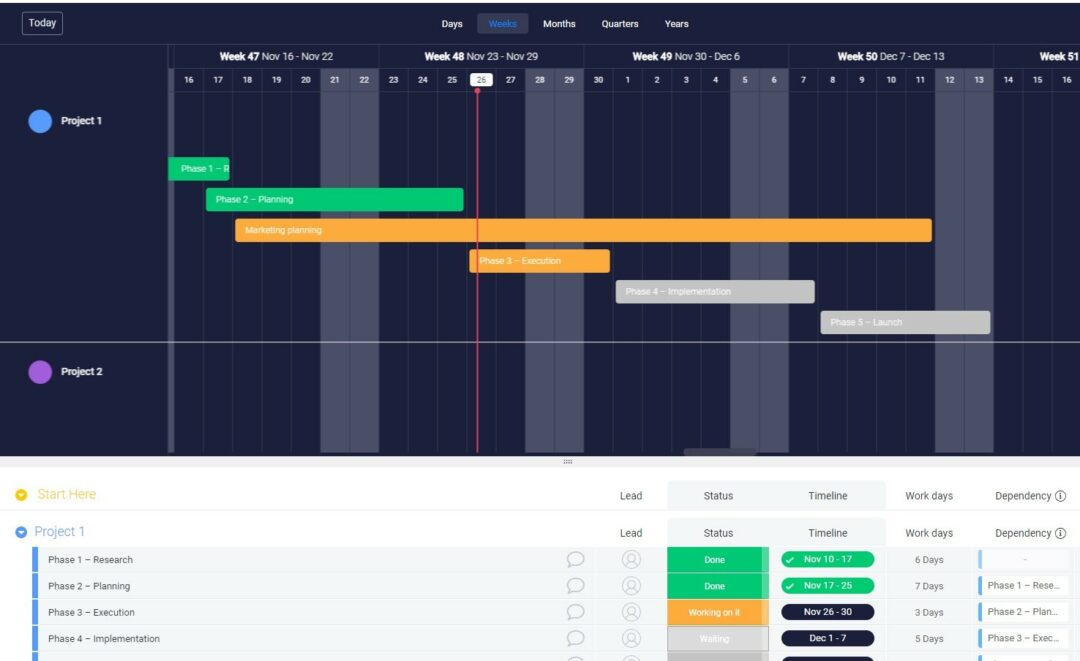Project management planning software: what to look for
Blog: Monday Project Management Blog
When planning projects, many companies still settle for low-tech solutions like spreadsheets or PowerPoint presentations.
It’s like that uncle we all have — the one who insists on using a flip phone. Does it get the job done? Sure.
But does it give Uncle Dave all the same options and conveniences as a modern solution? Not even close.
Don’t be Uncle Dave.
With a dedicated project planning platform, you can easily plan every aspect of your project, set and track KPIs, and much more.
In this article, we’ll teach you what features to look for in project management planning software and how to use it to eliminate unnecessary manual tasks and speed up your process.
What is project management planning software?
Project management planning software is a software solution that lets you plan, visualize, and rearrange your project schedule and dependencies.
Use it to get a feel for how long a project will take ahead of time, develop a more accurate project plan, and distribute the workload evenly.
Basically, it makes your job of planning projects a lot easier (as the name suggests). When you’re first initiating a project, it can be hard to grasp the timeline. You may not know when it makes sense to start each stage.
Instead of messing around with spreadsheets or drawing out a flowchart by hand, you can plug all the moving parts into the management software and let it show you what your project looks like.
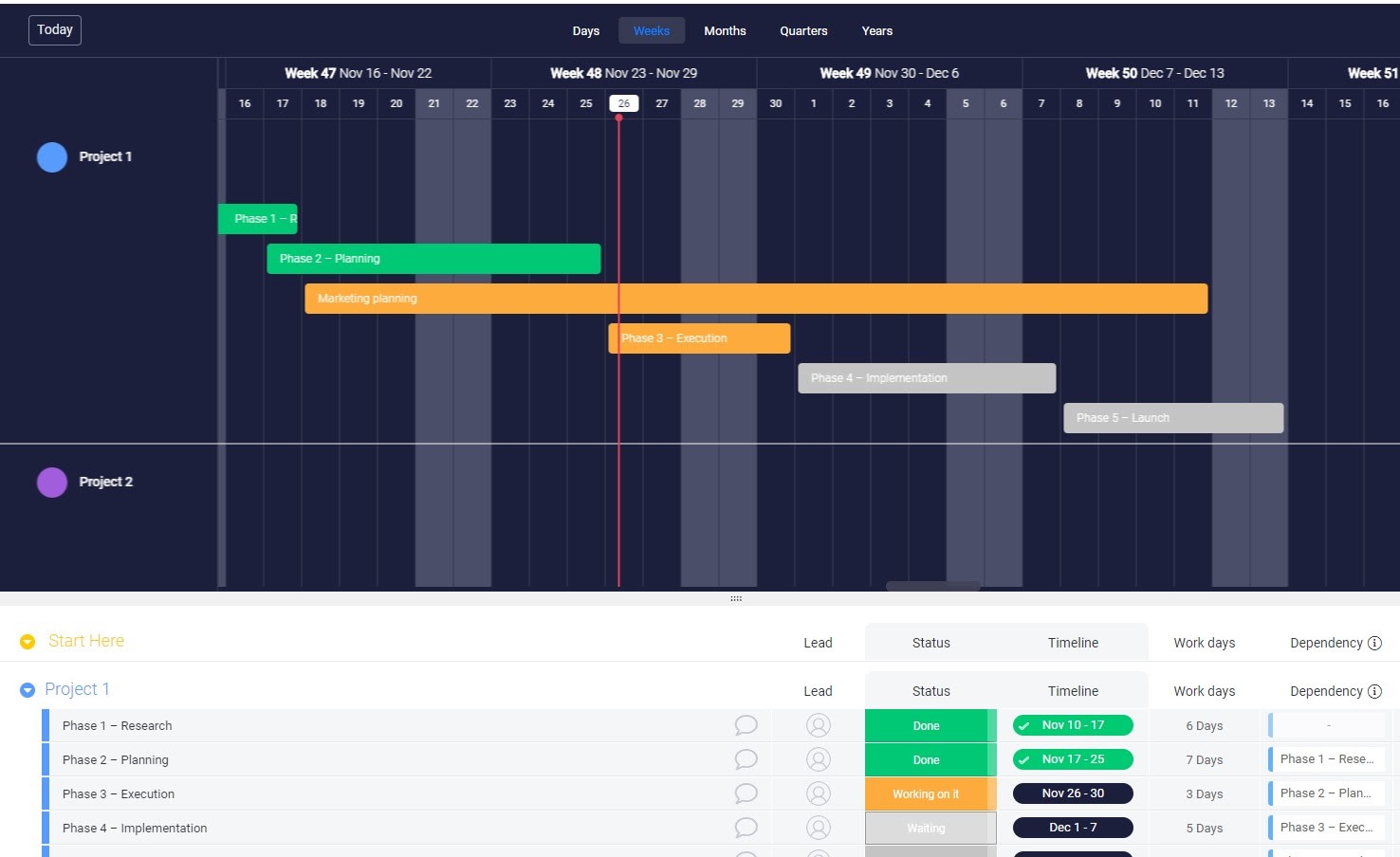
For example, this is the Gantt chart view in monday.com, where you can see your timeline and dependencies on the board.
By entering your estimated duration for each phase, you can immediately see how long your entire project is. You can also get a feel for when you should initiate the different stages.
Common features in a project management app
Of course, visualization isn’t the whole story of planning tools. A good platform has a ton of different features that makes project planning a breeze.
- Templates: there’s no need to start from scratch with every project. Templates outline a specific framework or workflow, saving you time and effort.
- Timeline visualization: a Gantt chart or some other way to see the timeline of the project.
- Dependencies: highlight any activity or project task that you can’t start without doing another task first. This feature will help you schedule the project in the right order.
- Workload balancing: if you assign too much work to a single person, they won’t be able to finish their tasks on time. It will delay the project. Workload management tools help you check that everyone has an achievable amount of work, based on your estimates.
- Sharing and collaboration: no project plan should be made in a vacuum. Sharing and collaboration tools help your whole team work together to include everyone’s ideas and priorities.
Why you need project management software
Every company needs project planning software because even a medium-sized project is an incredibly complex undertaking. Without a system in place, it’s easy for information to get lost in translation as people share and collaborate on files or documents.
In a recent study, 31% of project managers singled out poor upfront planning as a primary reason for their failure. 28% cited inadequate vision or goals for the project
For any project, you need to plan and establish:
- The objectives and vision
- All deliverables
- Individual task management
- The project timeline
- The project team or teams
- Stakeholder relationships and engagement
- Potential risks and pitfalls
- Resource management: usage of staff, equipment, and budget
You must also ensure that the objectives and benefits are delivered, not just half-measure project outcomes.
Good luck managing all of these factors in spreadsheets, or worse, on physical paper.
Plus, planning doesn’t end when you’ve initiated a project. That’s when the real work of monitoring, managing, and adjusting your plan starts.
And the average project manager spends a day or more each month manually preparing reports on the project status.
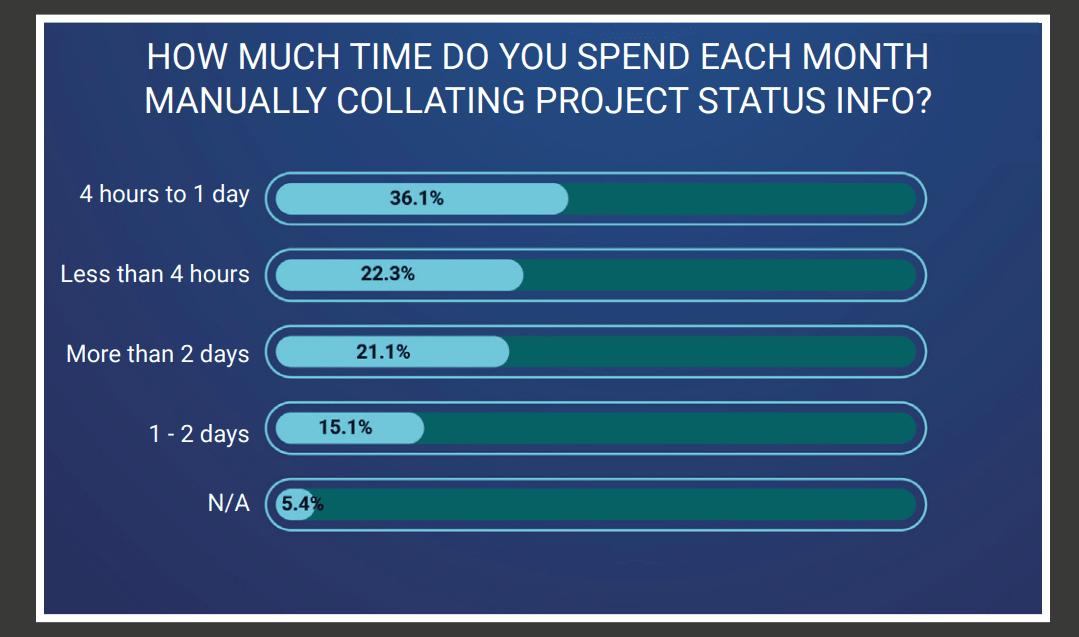
With a mishmash system of multiple tools, or no system at all, you might end up spending most of your reporting. That’s an ineffective use of your time. Instead, you could be managing teams, adjusting your course, or contributing directly to the project.
With an effective project management platform like monday.com reporting is, more or less, done for you. Real-time dashboards integrate data from multiple sources and give everyone a snapshot of the performance of your project.
Join the managers who only spend a few minutes each week on reporting.
What to look for in project management planning software
There are over 200 different project management tools and software solutions available on the market. Trying to choose between all of those options can be overwhelming.
To help you out, we’ll cover the most important indications that a platform will help improve your planning process below.
A variety of views that suit your workflows
A single static view doesn’t lend itself well to project planning. With a range of options, you can easily explore different aspects of a project and make sure everyone can interact with the software in their preferred way.
For example, you can use a Kanban board view to make brainstorming and high-level project planning a lot easier.

Further, a Gantt chart or other visualization tool can help you understand and adjust the project schedule before starting a project.
monday.com offers the following views to help you plan and manage your project:
- Standard grid view with color-coded statuses for an easy overview of how your project is doing.
- Gantt and timeline view to help you visualize the project timeline and schedule.
- Calendar view to help you single out particular milestones and dates.
- Kanban view to help you collaborate on ideas and brainstorm at a high level.
- Workload view to help you make sure nobody on the project team is overworked.
- Chart view to give you a breakdown of team and individual performance, and the current state of the project in terms of milestones and work item status.
By default, each project will only have the standard grid view to keep things simple. From there, you can easily add or remove views from each board to suit your workflow.
When choosing project planning software, more views really are better. Just like with ice cream flavors, there’s a time, place, and person for each one.
Ready-made templates for every stage of planning and execution
When trying to find the right software, many teams and managers overlook this factor. But templates cut down on guesswork and help you focus on meaningful action when planning projects.
monday.com offers over 100 different templates tailored to different workflows and stages of the project management process.
For example, if you want to manage the project at a higher level, you can use the project management plan template.
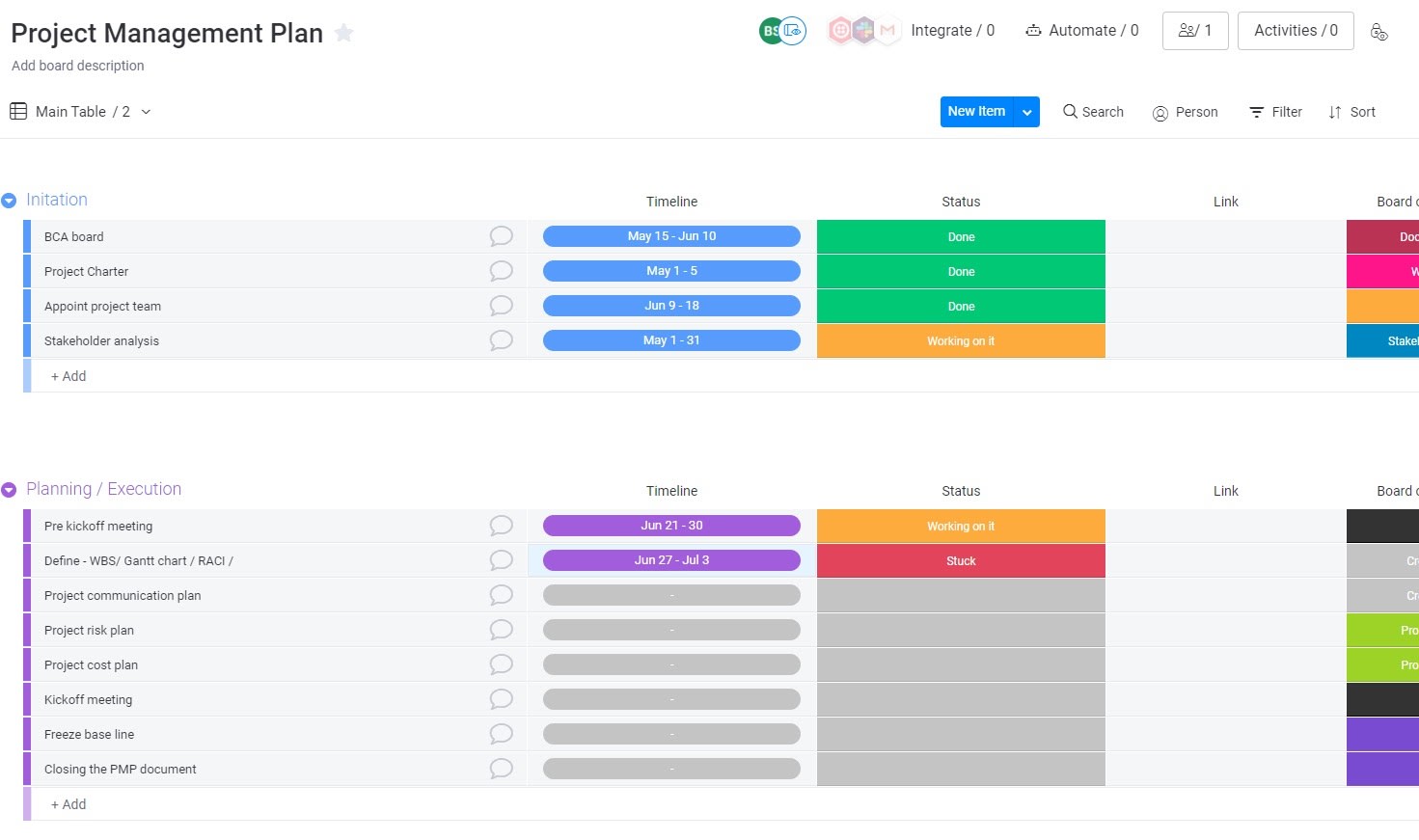
It guides you through each stage of the entire planning process. It also points out specific boards and other planning deliverables you should create throughout the process.
Even if you’re new to the project management life cycle, it helps you master it. Follow along to plan more thoroughly, and retake control over your projects.
For a more basic team workflow board, you can easily customize any table to suit your needs. For a multi-stage approval process, you can edit columns, status labels, and more.
Once you’re happy with an edited template, you can easily save and reuse it for future projects or other teams.
The flexibility of monday.com is what makes it possible to use a single platform across departments. It’s not like your HR team has the same workflow or preferences as your development team, after all.
Real-time project status reports and dashboards
Don’t make your managers spend several days on reporting every month. Make it easy for them — and yourself — by choosing a platform with real-time project status reports.
Look for solutions that let you create custom dashboards to highlight your KPIs, rather than a standard one. The metrics you care about depend on your industry, company, and department.
By tracking individual teams, members, and work items, monday.com has up-to-second data on the status of every project.
Your managers or teams can highlight the metrics they want by creating a custom dashboard, using simple drag and drop widgets.
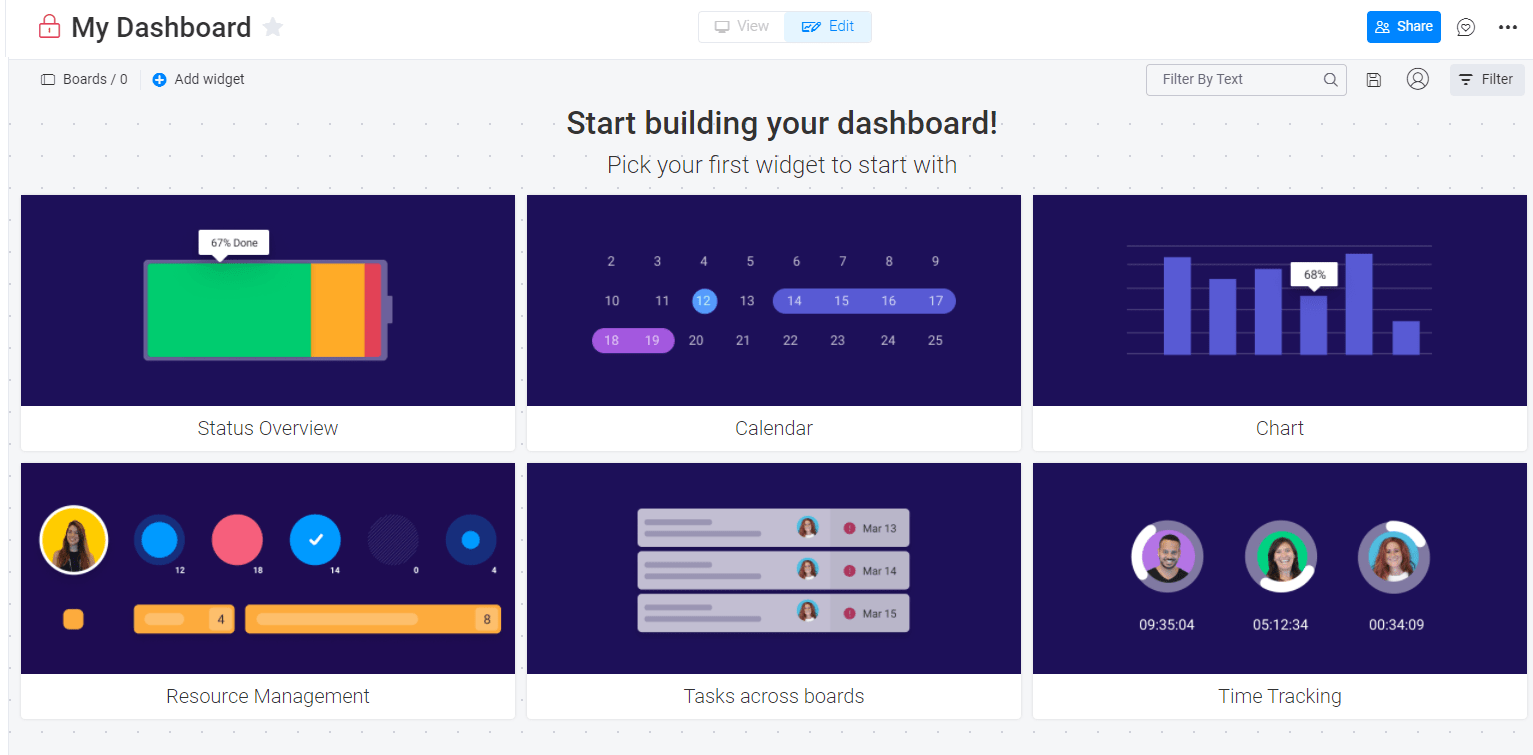
And to save you the need to compile data, we also integrate with many other apps and platforms.
For example, you can include data from your CRM, ad platform, helpdesk software, and more.
You can use monday.com to centralize data from multiple sources and create a single, comprehensive dashboard of overall performance.
Your managers will no longer need to have 12 tabs open and hop between them to try to make sense of the data. Instead, they can access one dashboard from anywhere, even our mobile app.
Extensive integrations
If your new platform doesn’t integrate with your existing tools, it might as well be an island. It definitely won’t serve as the foundation for a more collaborative workflow.
Look for software that integrates with core tools your different departments use and love. That’s the only way to bridge the data and collaboration gap between your teams.
monday.com boasts robust native integrations with communication tools, CRMs, marketing platforms, and much more.

Even if you’ve got teams spread out through Slack, Microsoft Teams, and even email, we’ve got you covered.
Integrations are the digital glue that binds your different teams together.
Real-time collaboration
When choosing software, make sure you prioritize options that make it easy for your team to work together.
For example, monday.com gives your entire team real-time access to view and edit boards. You can also add comments directly to specific project boards to ask questions or solve problems.

- Comment directly on work items and files to make sure all information is in a relevant place. Nothing will “get lost” in long message or email threads.
- Threaded discussions keep things easily manageable.
- Attach files to highlight issues or as part of a review process.
- Mentions and notifications make sure the right people get the message at the right time.
Remember that it’s not just the members of your project team that you need to collaborate with.
Leaving the people who’re paying for or using the project out of the loop isn’t a good idea. Thankfully, that’s not a lesson we’ve had to learn first-hand. And you don’t have to either.
Guest user access makes it easy to share and collaborate with external stakeholders like your project sponsor or VIP customers.
A stellar customer reputation
Your next choice should be for the long term. The last thing you want is to choose an unreliable provider, forcing you to switch to other software yet again.
This isn’t the Premier League. Jumping from one option to the next isn’t a blueprint for getting filthy rich. Instead, switching costs you money and effort.
It takes time for the team to get used to new software, no matter how intuitive.
So you need to do your homework and find an option with a stellar customer reputation. Someone you can rely on for the long term.
monday.com boasts an average rating of 4.6/5 on both Trustpilot and G2, with the vast majority of reviewers dropping a full 5/5 rating.
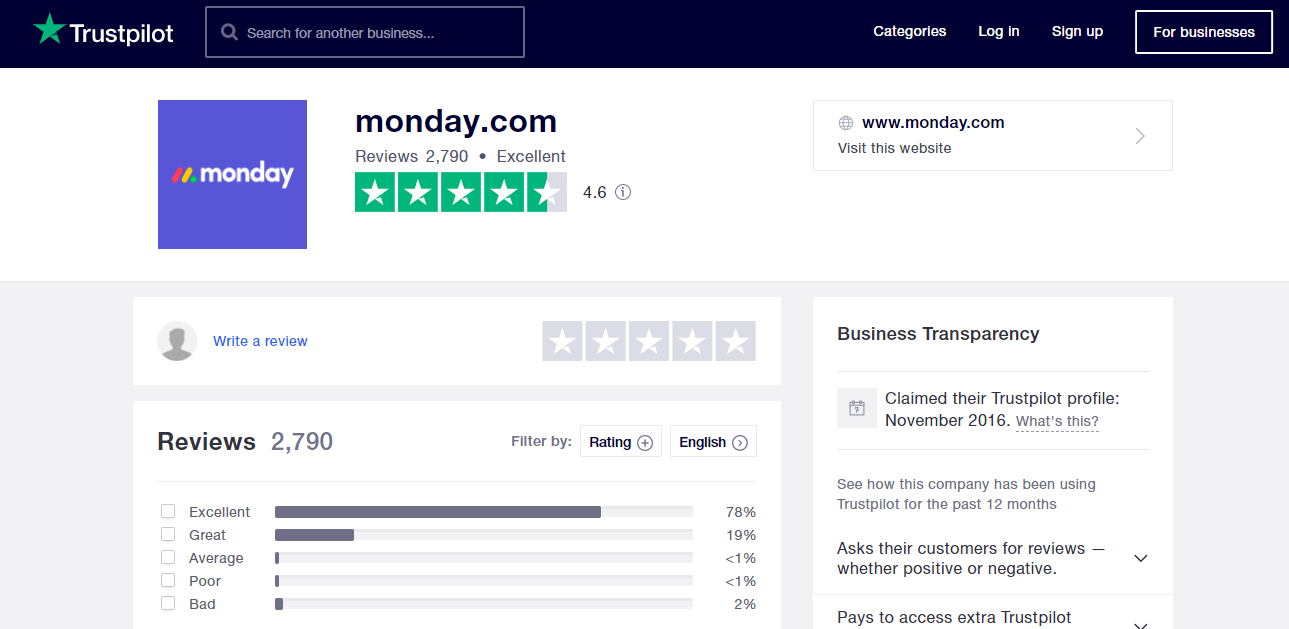
If you don’t think the switch will last, it’s not worth making.
Hopefully, after reading through some of our features, you’ll realize that monday.com has what it takes to be the new forever home of your projects.
We’ve got everything you need. Not just for planning, but for mastering every stage of project management. Plus, our always-game support team has your back every step of the way.
There’s a reason we keep getting 5-star ratings and winning awards, just saying.
How to make the adoption of the new software painless
If you’re not careful, getting your organization to adopt new software can be a massive challenge. Even in 2020, 82% of companies introducing new technology struggled with adoption issues.
Here’s what you do to make a 100% pain-free switch.
Choose an intuitive, easy-to-use platform that integrates with your existing tools.
The first step is to choose the right project management solution in the first place. There’s a big difference between simple planning tools and a platform that makes your life easier.
If it’s just another tool, it’ll be easy for your staff to dismiss and avoid using it. After all, the average employee already uses more than 10 apps to get their work done.
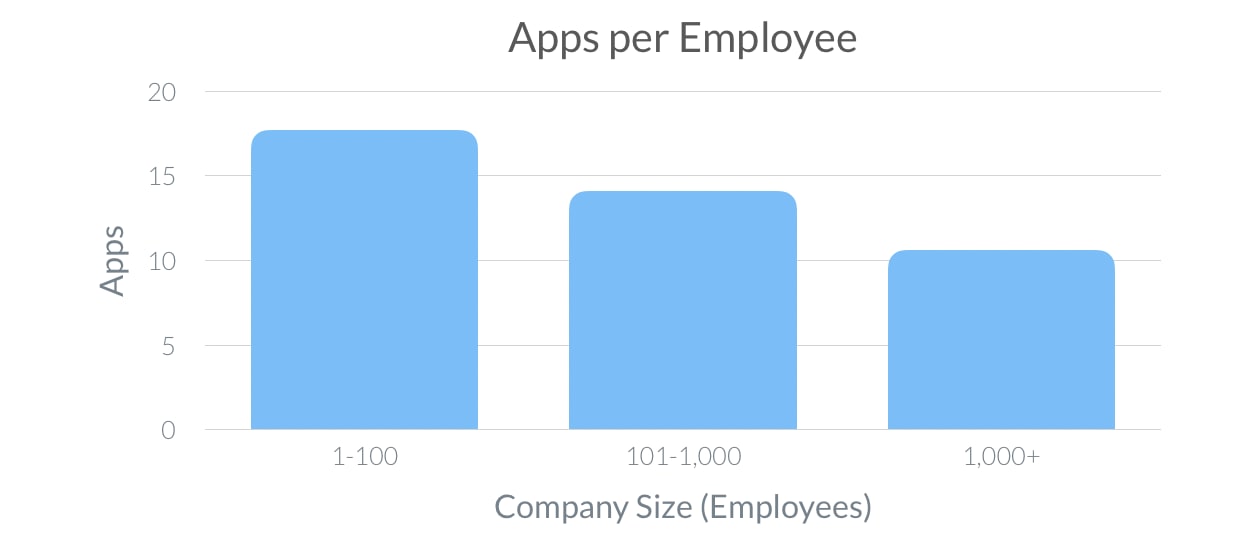
In some small offices, employees have more apps than actual coworkers. Welcome to the digital age.
So what’s the alternative? Choose a platform that integrates with many existing tools and lays the foundation for a better work experience.
If it becomes the digital workspace where all work happens, people will start to use it naturally.
Choose the right software, and the road to adoption becomes a whole lot easier.
Give ample notice and time to learn the new platform.
Telling your whole team to “just make the switch” is a horrible idea.
Sure, your savviest members might figure it out in a few minutes. But for everyone else, you’re considerably slowing down their workflow and increasing the risk of making mistakes.
The wrong approach could put multiple projects at risk.
Instead, do this:
- Give every team member the time they need to get familiar with the new platform.
- Schedule in time to learn it during working hours in the week leading up to the switch.
Adults are even more likely to skip homework than schoolchildren. So don’t pretend your staff will learn it at home, for free.
Single out and train an evangelist in each team.
Once you’ve committed to making the switch, the next step is to speed up the adoption process.
Giving everyone time and some basic training is a good start. But alone, it won’t be enough. For your company to use the new software to its full potential, you need to recruit linchpins for change.
Single out a member of each team to be an evangelist for the new software. Make sure they get more training and can act as innovators and leaders.
Don’t get blinded by seniority. Choose someone savvy who loves to be an early adopter. Someone who always shows up to work with the newest gadgets is the right choice.
Make sure everyone understands the value.
Even if you make the final decision, planning and executing projects right takes a village.
On average, monday.com users collaborate with 11 people when working on a project.
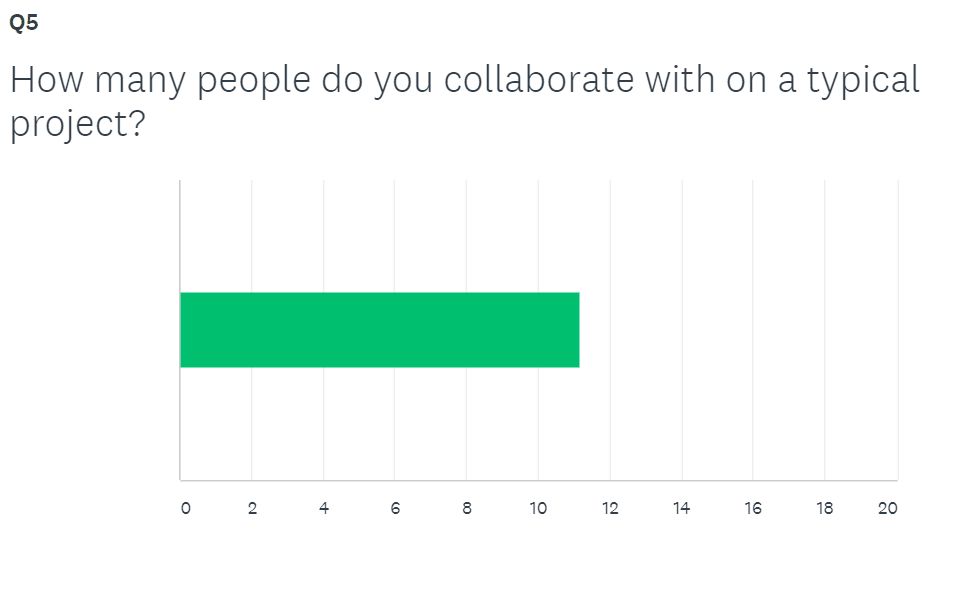
All the people involved need to understand the value before you try to make a switch.
So, put it on the company agenda. Hold workshops. Ask employees for their opinions.
Make sure that everyone understands the value before you announce the switch.
Conclusion
Without the right project management software, your managers will waste countless hours on unnecessary manual tasks.
Look for solutions with ready-made templates, customizable KPI dashboards and reports, and extensive integrations.
Use our project management plan template to outline the different stages of your project, objectives, deliverables, and more. Take back control of your projects in mere minutes.
The post Project management planning software: what to look for appeared first on monday.com Blog.
Leave a Comment
You must be logged in to post a comment.
